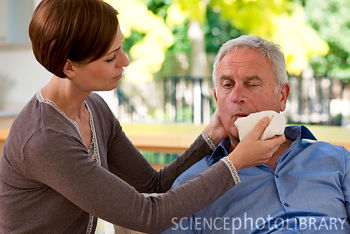最新一项研究表明,重度中风后双腿能弯曲的的病人比不能弯曲的病人更易康复。这项研究结果发表在10月11日出版的美国神经学《 Neurology》杂志上。

论文的作者慕尼黑大学Berend Feddersen博士说,病人重度中风后,会有行动不便甚至意识减弱的后遗症,但我们发现一些病人仍可以弯曲双腿,这并不像看起来那么简单。一旦结论成立,医生便可以根据这一现象来判断哪些病人更有可能康复。
重度中风后的15天内,能够双腿弯曲的病人日常生活更有可能自理,患神经性疾病的可能较小,死亡率也相对较低。
这项研究纳入了68位重度中风需要精心照顾的病人,设有通风和促进循环的设备。根据双腿能否弯曲将他们分为两组,进行为期一年的观察,记录他们的情况。
一年之后,双腿能弯曲小组的患者死亡率只有9%,而另一组高达53%。双腿能够弯曲小组的患者出院后患神经性疾病的也较少,同时美国国立卫生研究院卒中量表为平均6.5分,明显低于另一小组的10.6。
根据Rankin量表双腿能弯曲的小组为2.9级,表明他们是中度残障,能无须他人协助自己行走。而另一组则是5级,意味着他们是严重残障并且需要持续的照顾。而另一项Barthel Index(日常生活活动能力量表)调查也显示,双腿弯曲的小组的患者能够更好的自理。(生物探索 millie)
相关英文论文摘要:
The crossed leg sign indicates a favorable outcome after severe stroke
Objective: We investigated whether crossed legs are a prognostic marker in patients with severe stroke.
Methods: In this controlled prospective observational study, we observed patients with severe stroke who crossed their legs during their hospital stay and matched them with randomly selected severe stroke patients who did not cross their legs. The patients were evaluated upon admission, on the day of leg crossing, upon discharge, and at 1 year after discharge. The Glasgow Coma Scale, the NIH Stroke Scale (NIHSS), the modified Rankin Scale (mRS), and the Barthel Index (BI) were obtained.
Results: Patients who crossed their legs (n = 34) and matched controls (n = 34) did not differ in any scale upon admission. At the time of discharge, the GCS did not differ, but the NIHSS was better in crossed legs patients (6.5 vs 10.6; p = 0.0026), as was the mRS (3.4 vs 5.1, p < 0.001), and the BI (34.0 vs 21.1; p = 0.0073). At 1-year follow-up, mRS (2.9 vs 5.1, p < 0.001) and the BI (71.3 vs 49.2; p = 0.045) were also better in the crossed leg group. The mortality between the groups differed grossly; only 1 patient died in the crossing group compared to 18 in the noncrossing group (p < 0.001).
Conclusion: Leg crossing is an easily obtained clinical sign and is independent of additional technical examinations. Leg crossing within the first 15 days after severe stroke indicates a favorable outcome which includes less neurologic deficits, better independence in daily life, and lower rates of death.
英文论文链接:https://www.neurology.org/content/77/15/1453.abstract?sid=d19fab28-9a52-4a1d-b4a4-2422d9052147







